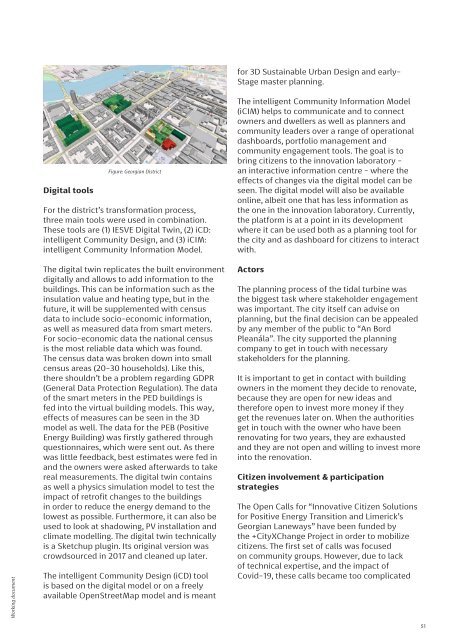Cities4PEDs Atlas_November 2021.pdf
Atlas - From 7 case interviews to recurring strategies and PED relevant aspects
Atlas - From 7 case interviews to recurring strategies and PED relevant aspects
- No tags were found...
You also want an ePaper? Increase the reach of your titles
YUMPU automatically turns print PDFs into web optimized ePapers that Google loves.
for 3D Sustainable Urban Design and early-<br />
Stage master planning.<br />
Digital tools<br />
Figure: Georgian District<br />
For the district’s transformation process,<br />
three main tools were used in combination.<br />
These tools are (1) IESVE Digital Twin, (2) iCD:<br />
intelligent Community Design, and (3) iCIM:<br />
intelligent Community Information Model.<br />
The intelligent Community Information Model<br />
(iCIM) helps to communicate and to connect<br />
owners and dwellers as well as planners and<br />
community leaders over a range of operational<br />
dashboards, portfolio management and<br />
community engagement tools. The goal is to<br />
bring citizens to the innovation laboratory -<br />
an interactive information centre - where the<br />
effects of changes via the digital model can be<br />
seen. The digital model will also be available<br />
online, albeit one that has less information as<br />
the one in the innovation laboratory. Currently,<br />
the platform is at a point in its development<br />
where it can be used both as a planning tool for<br />
the city and as dashboard for citizens to interact<br />
with.<br />
Working document<br />
The digital twin replicates the built environment<br />
digitally and allows to add information to the<br />
buildings. This can be information such as the<br />
insulation value and heating type, but in the<br />
future, it will be supplemented with census<br />
data to include socio-economic information,<br />
as well as measured data from smart meters.<br />
For socio-economic data the national census<br />
is the most reliable data which was found.<br />
The census data was broken down into small<br />
census areas (20-30 households). Like this,<br />
there shouldn’t be a problem regarding GDPR<br />
(General Data Protection Regulation). The data<br />
of the smart meters in the PED buildings is<br />
fed into the virtual building models. This way,<br />
effects of measures can be seen in the 3D<br />
model as well. The data for the PEB (Positive<br />
Energy Building) was firstly gathered through<br />
questionnaires, which were sent out. As there<br />
was little feedback, best estimates were fed in<br />
and the owners were asked afterwards to take<br />
real measurements. The digital twin contains<br />
as well a physics simulation model to test the<br />
impact of retrofit changes to the buildings<br />
in order to reduce the energy demand to the<br />
lowest as possible. Furthermore, it can also be<br />
used to look at shadowing, PV installation and<br />
climate modelling. The digital twin technically<br />
is a Sketchup plugin. Its original version was<br />
crowdsourced in 2017 and cleaned up later.<br />
The intelligent Community Design (iCD) tool<br />
is based on the digital model or on a freely<br />
available OpenStreetMap model and is meant<br />
Actors<br />
The planning process of the tidal turbine was<br />
the biggest task where stakeholder engagement<br />
was important. The city itself can advise on<br />
planning, but the final decision can be appealed<br />
by any member of the public to “An Bord<br />
Pleanála”. The city supported the planning<br />
company to get in touch with necessary<br />
stakeholders for the planning.<br />
It is important to get in contact with building<br />
owners in the moment they decide to renovate,<br />
because they are open for new ideas and<br />
therefore open to invest more money if they<br />
get the revenues later on. When the authorities<br />
get in touch with the owner who have been<br />
renovating for two years, they are exhausted<br />
and they are not open and willing to invest more<br />
into the renovation.<br />
Citizen involvement & participation<br />
strategies<br />
The Open Calls for “Innovative Citizen Solutions<br />
for Positive Energy Transition and Limerick’s<br />
Georgian Laneways” have been funded by<br />
the +CityXChange Project in order to mobilize<br />
citizens. The first set of calls was focused<br />
on community groups. However, due to lack<br />
of technical expertise, and the impact of<br />
Covid-19, these calls became too complicated<br />
51


















